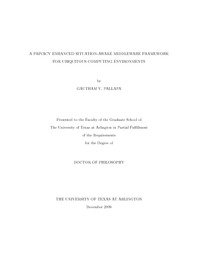| dc.description.abstract | The Ubiquitous Computing paradigm integrates myriads of small, inexpensive, heterogeneous networked devices, including sensors, distributed throughout the environment, with the intent of enabling context awareness in systems deployed to monitor the environment. This is accomplished by monitoring events, such as access, or utilization of resources, and obtaining knowledge about user activities, and interactions with other entities in the environment. Existing context-aware systems predominantly encapsulate the occurred activities either by using Event-Condition-Action rules, where an instance of the event performs as a trigger, or by prediction mechanisms, such as Dynamic Bayesian Networks, which compute decisions, based on the information obtained. However, these approaches are constrained by computational overheads, rule complexities, and potential loss of information, introduced by deconstructing activities. This emphasizes the need for a "natural interaction" paradigm involving the input from the user and the environment in a cooperative manner, making it imperative to understand the potential relationship between activity and the embedded context information. In this dissertation, user activity is described by a finite number of states called situations, characterized by interaction with other entities or devices in the environment. The information perceived from these situations, enable systems deployed in the environment to monitor interactions, and develop dynamic rules customized to the user. Deploying such systems on a significant scale, however, introduces the additional challenge of protecting information among users, thereby accentuating the need for robust privacy management.This dissertation focuses on the challenges of situation perception, user privacy, and human-computer interaction through ubiquitous middleware. We investigate the limitations of deconstructing context to capture information required to describe situations. We discuss our approach to understand user interactions as situations, by introducing the concept of situation trees, built by parsing the sequence of contexts and device information obtained from the monitored environment. We then present our scheme to build the vocabulary and situation grammar from the situation trees, which facilitates behavior-specific dynamic rule generation, and demonstrate the potential of our scheme for efficient decision making. This dissertation also looks at the conundrum of privacy, and we have devised various approaches to quantify user privacy in ubiquitous computing environment. We compare these approaches in various scenarios, and present our experimental results and findings. We finally present the design of our ubiquitous middleware framework to support the perception, modeling, rule generation, and privacy management of user interactions, and examine the effectiveness of our framework in an assisted environment. The experimental results presented in this dissertation substantiate the effectiveness of our approach to situation modeling and privacy quantization. | en_US |

